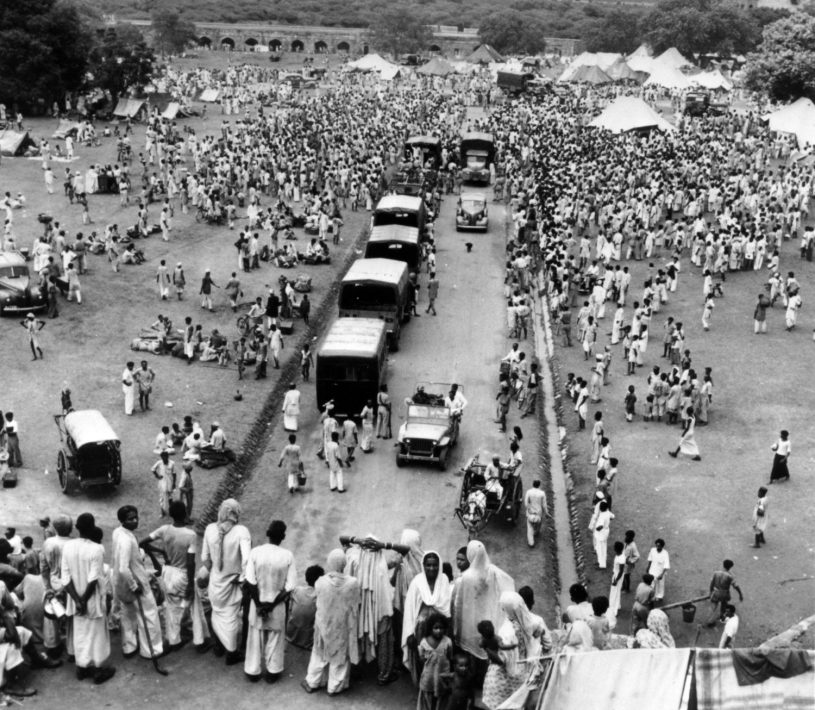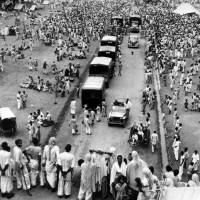How the Partition of India happened – and why its effects are still felt today
 “Partition” – the division of British India into the two separate states of India and Pakistan on August 14-15, 1947 – was the “last-minute” mechanism by which the British were able to secure agreement over how independence would take place. At the time, few people understood what Partition would entail or what its results would be, and the migration on the enormous scale that followed took the vast majority of contemporaries by surprise.
“Partition” – the division of British India into the two separate states of India and Pakistan on August 14-15, 1947 – was the “last-minute” mechanism by which the British were able to secure agreement over how independence would take place. At the time, few people understood what Partition would entail or what its results would be, and the migration on the enormous scale that followed took the vast majority of contemporaries by surprise.
The main vehicle for nationalist activity was the Indian National Congress, whose best-known leaders included Mahatma Gandhi and Jawaharlal Nehru. Even before the 1940s, it had long argued for a unitary state with a strong centre; even though Congress was ostensibly secular in its objectives, organisations representing minority interests increasingly viewed this idea with suspicion, believing that it would entrench the political dominance of Hindus, who made up about 80% of the population.
At around 25% of its population, Muslims were British India’s largest religious minority. Under imperial rule, they had grown accustomed to having their minority status protected by a system of reserved legislative seats and separate electorates. The British system of political control hinged on identifying interest groups willing to collaborate, a governing style often described as “divide and rule”.
The prospect of losing this protection as independence drew closer worried more and more Muslims, first in parts of northern India, and then, after World War II, in the influential Muslim-majority provinces of Bengal and Punjab. In 1945-6, the All-India Muslim League, led by Muhammad Ali Jinnah, won a majority of Muslim votes in provincial elections. This strengthened the party’s claim to speak for a substantial proportion of, but never all, the subcontinent’s Muslims.
Then came World War II – and suddenly, the political stakes in India were considerably higher.
The end of the Raj
When Britain took India into the war without consultation in 1939, Congress opposed it; large nationalist protests ensued, culminating in the 1942 Quit India movement, a mass movement against British rule. For their part in it, Gandhi and Nehru and thousands of Congress workers were imprisoned until 1945.
Meanwhile, the British wartime need for local allies gave the Muslim League an opening to offer its cooperation in exchange for future political safeguards. In March 1940, the Muslim League’s “Pakistan” resolution called for the creation of “separate states” – plural, not singular – to accommodate Indian Muslims, whom it argued were a separate “nation”.
Historians are still divided on whether this rather vague demand was purely a bargaining counter or a firm objective. But while it may have been intended to solve the minority issue, it ended up aggravating it instead.
After the war, Attlee’s Labour government in London recognised that Britain’s devastated economy could not cope with the cost of the over-extended empire. A Cabinet Mission was dispatched to India in early 1946, and Attlee described its mission in ambitious terms:
My colleagues are going to India with the intention of using their utmost endeavours to help her to attain her freedom as speedily and fully as possible. What form of government is to replace the present regime is for India to decide; but our desire is to help her to set up forthwith the machinery for making that decision.
An act of parliament proposed June 1948 as the deadline for the transfer of power. But the Mission failed to secure agreement over its proposed constitutional scheme, which recommended a loose federation; the idea was rejected by both Congress and the Muslim League, which vowed to agitate for “Pakistan” by any means possible.
All the while, communal violence was escalating. In August 1946, the Great Calcutta Killing left some 4,000 people dead and a further 100,000 homeless.
By March 1947, a new viceroy, Lord Louis Mountbatten, arrived in Delhi with a mandate to find a speedy way of bringing the British Raj to an end. On June 3, he announced that independence would be brought forward to August that year, presenting politicians with an ultimatum that gave them little alternative but to agree to the creation of two separate states.
Pakistan – its eastern and western wings separated by around 1,700 kilometres of Indian territory – celebrated independence on August 14 that year; India did so the following day. The new borders, which split the key provinces of the Punjab and Bengal in two, were officially approved on August 17. They had been drawn up by a Boundary Commission, led by British lawyer Cyril Radcliffe, who later admitted that he had relied on out-of-date maps and census materials.
Torn apart
Partition triggered riots, mass casualties, and a colossal wave of migration. Millions of people moved to what they hoped would be safer territory, with Muslims heading towards Pakistan, and Hindus and Sikhs in the direction of India. As many as 14-16m people may have been eventually displaced, travelling on foot, in bullock carts and by train.
Estimates of the death toll post-Partition range from 200,000 to two million. Many were killed by members of other communities and sometimes their own families, as well as by the contagious diseases which swept through refugee camps. Women were often targeted as symbols of community honour, with up to 100,000 raped or abducted.
What can explain this intensely violent reaction? Many of the people concerned were very deeply attached not just to religious identity, but to territory, and Britain was reluctant to use its troops to maintain law and order. The situation was especially dangerous in Punjab, where weapons and demobilised soldiers were abundant.
Another unforeseen consequence of Partition was that Pakistan’s population ended up more religiously homogeneous than originally anticipated. The Muslim League’s leaders had assumed that Pakistan would contain a sizeable non-Muslim population, whose presence would safeguard the position of Muslims remaining in India – but in West Pakistan, non-Muslim minorities comprised only 1.6% of the population by 1951, compared with 22% in East Pakistan (now Bangladesh).
And even though Pakistan was ostensibly created as a “homeland” for India’s Muslim minority, not all Muslims even supported its formation, never mind migrated there: Muslims remained the largest minority group in independent India, making up around 10% of the population in 1951. Gandhi himself was assassinated in January 1948 by a Hindu nationalist extremist who blamed him for being too supportive of Muslims at the time of Partition.
Both states subsequently faced huge problems accommodating and rehabilitating post-Partition refugees, whose numbers swelled when the two states went to war over the disputed territory of Jammu and Kashmir in 1947-8. Later bouts of communal tension generated further movement, with a trickle of people still migrating as late as the 1960s.
Today, the two countries’ relationship is far from healthy. Kashmir remains a flashpoint; both countries are nuclear-armed. Indian Muslims are frequently suspected of harbouring loyalties towards Pakistan; non-Muslim minorities in Pakistan are increasingly vulnerable thanks to the so-called Islamisation of life there since the 1980s. Seven decades on, well over a billion people still live in the shadow of Partition.































